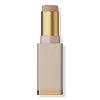Anastasia Beverly Hills Smooth Blur Cream Contour Stick Versus Lancôme Teint Idole Ultra 24H Long Wear Matte Foundation
What's inside
What's inside
 Key Ingredients
Key Ingredients

 Benefits
Benefits

No benefits
 Concerns
Concerns

 Ingredients Side-by-side
Ingredients Side-by-side

Dimethicone
EmollientPolyglyceryl-2 Triisostearate
EmulsifyingIsononyl Isononanoate
EmollientSynthetic Wax
AbrasivePhenyl Trimethicone
Skin ConditioningSilica
AbrasiveEthylene/Propylene Copolymer
AbrasiveRhus Succedanea Fruit Wax
Dimethicone/Vinyl Dimethicone Crosspolymer
Skin ConditioningPolysilicone-11
Mica
Cosmetic ColorantTriethoxycaprylylsilane
Caprylyl Glycol
EmollientTocopheryl Acetate
AntioxidantAluminum Hydroxide
EmollientCI 77491
Cosmetic ColorantCI 77492
Cosmetic ColorantCI 77499
Cosmetic ColorantCI 15850
Cosmetic ColorantCI 77891
Cosmetic ColorantDimethicone, Polyglyceryl-2 Triisostearate, Isononyl Isononanoate, Synthetic Wax, Phenyl Trimethicone, Silica, Ethylene/Propylene Copolymer, Rhus Succedanea Fruit Wax, Dimethicone/Vinyl Dimethicone Crosspolymer, Polysilicone-11, Mica, Triethoxycaprylylsilane, Caprylyl Glycol, Tocopheryl Acetate, Aluminum Hydroxide, CI 77491, CI 77492, CI 77499, CI 15850, CI 77891
Water
Skin ConditioningDimethicone
EmollientIsododecane
EmollientAlcohol Denat.
AntimicrobialTrimethylsiloxysilicate
EmollientButylene Glycol
HumectantPEG-10 Dimethicone
Skin ConditioningPerlite
AbsorbentSynthetic Fluorphlogopite
Moringa Oleifera Seed Extract
Skin ConditioningPolymnia Sonchifolia Root Juice
Skin ConditioningCalcium Aluminum Borosilicate
Glycerin
HumectantDipentaerythrityl Tetrahydroxystearate/Tetraisostearate
Skin ConditioningAlpha-Glucan Oligosaccharide
CleansingSodium Hyaluronate
HumectantSilica
AbrasiveSilica Silylate
EmollientHdi/Trimethylol Hexyllactone Crosspolymer
Cellulose
AbsorbentAluminum Hydroxide
EmollientMagnesium Sulfate
Nylon-12
Disodium Phosphate
BufferingDisodium Stearoyl Glutamate
CleansingIsopropyl Lauroyl Sarcosinate
Skin ConditioningHydrogen Dimethicone
Citric Acid
BufferingDiisopropyl Sebacate
EmollientBis-PEG/PPG-14/14 Dimethicone
EmollientLactobacillus
Skin ConditioningMaltodextrin
AbsorbentDisteardimonium Hectorite
StabilisingBHT
AntioxidantTocopherol
AntioxidantPhenoxyethanol
PreservativeTitanium Dioxide
Cosmetic ColorantIron Oxides
Water, Dimethicone, Isododecane, Alcohol Denat., Trimethylsiloxysilicate, Butylene Glycol, PEG-10 Dimethicone, Perlite, Synthetic Fluorphlogopite, Moringa Oleifera Seed Extract, Polymnia Sonchifolia Root Juice, Calcium Aluminum Borosilicate, Glycerin, Dipentaerythrityl Tetrahydroxystearate/Tetraisostearate, Alpha-Glucan Oligosaccharide, Sodium Hyaluronate, Silica, Silica Silylate, Hdi/Trimethylol Hexyllactone Crosspolymer, Cellulose, Aluminum Hydroxide, Magnesium Sulfate, Nylon-12, Disodium Phosphate, Disodium Stearoyl Glutamate, Isopropyl Lauroyl Sarcosinate, Hydrogen Dimethicone, Citric Acid, Diisopropyl Sebacate, Bis-PEG/PPG-14/14 Dimethicone, Lactobacillus, Maltodextrin, Disteardimonium Hectorite, BHT, Tocopherol, Phenoxyethanol, Titanium Dioxide, Iron Oxides
 Reviews
Reviews

Ingredients Explained
These ingredients are found in both products.
Ingredients higher up in an ingredient list are typically present in a larger amount.
Aluminum Hydroxide is a form of aluminum. It can be naturally found in nature as the mineral gibbsite. In cosmetics, Aluminum Hydroxide is used as a colorant, pH adjuster, and absorbent.
As a colorant, Aluminum Hydroxide may add opacity, or reduce the transparency. Aluminum hydroxide is contains both basic and acidic properties.
According to manufacturers, this ingredient is an emollient and humectant. This means it helps hydrate the skin.
In medicine, this ingredient is used to help relieve heartburn and help heal ulcers.
There is currently no credible scientific evidence linking aluminum hydroxide in cosmetics to increased cancer risk.
Major health organizations allow the use of aluminum hydroxide in personal care products and have not flagged it as a carcinogenic risk at typical usage levels.
Learn more about Aluminum HydroxideDimethicone is a type of synthetic silicone created from natural materials such as quartz.
What it does:
Dimethicone comes in different viscosities:
Depending on the viscosity, dimethicone has different properties.
Ingredients lists don't always show which type is used, so we recommend reaching out to the brand if you have questions about the viscosity.
This ingredient is unlikely to cause irritation because it does not get absorbed into skin. However, people with silicone allergies should be careful about using this ingredient.
Note: Dimethicone may contribute to pilling. This is because it is not oil or water soluble, so pilling may occur when layered with products. When mixed with heavy oils in a formula, the outcome is also quite greasy.
Learn more about DimethiconeSilica, also known as silicon dioxide, is a naturally occurring mineral. It is used as a fine, spherical, and porous powder in cosmetics.
Though it has exfoliant properties, the function of silica varies depending on the product.
The unique structure of silica enhances the spreadability and adds smoothness, making it a great texture enhancer.
It is also used as an active carrier, emulsifier, and mattifier due to its ability to absorb excess oil.
In some products, tiny microneedles called spicules are made from silica or hydrolyzed sponge. When you rub them in, they lightly polish away dead skin layers and enhance the penetration of active ingredients.
Learn more about Silica